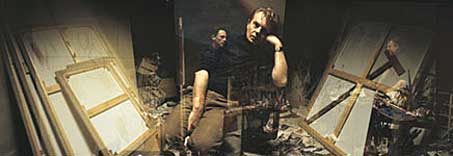|
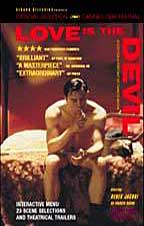
Love
is the Devil
Strand Releasing,
1998
Director/Screenplay:
John
Maybury
Starring:
Derek
Jacobi, Daniel Craig, Tilda Swinton, Anne Lambton, Adrian Scarborough,
Karl Johnson, Annabel Brooks, Richard Newbould
Unrated,
87 minutes
|
A
Portrait Of The Artist As An Old Queen
by
Michael D. Klemm
Reprinted
from Outcome, May, 2005
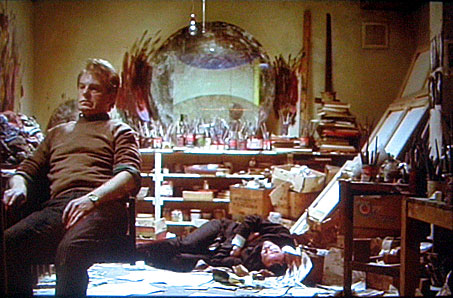
Director John Maybury
recently enjoyed mainstream success with the surreal thriller, The
Jacket. Back in 1998, however, he was testing the waters of independent
queer cinema with Love is the Devil, a
subversive bio-pic of British artist Francis Bacon.
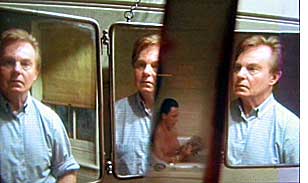 Like
many post-WWII artists, Bacon's collected work lays bare the horrors of
the modern world. He was dubbed "the greatest English painter since
Turner." Best known perhaps for his Screaming Pope series
- modeled on a famous canvas by Valesquez - Bacon's finest work deconstructed
the human figure. Spawned from his brush, his male nudes are often grotesquely
distorted, almost eviscerated. A ghostly canvas, (shown below), of two
wrestlers is homoerotic with an undercurrent of violence. Like
many post-WWII artists, Bacon's collected work lays bare the horrors of
the modern world. He was dubbed "the greatest English painter since
Turner." Best known perhaps for his Screaming Pope series
- modeled on a famous canvas by Valesquez - Bacon's finest work deconstructed
the human figure. Spawned from his brush, his male nudes are often grotesquely
distorted, almost eviscerated. A ghostly canvas, (shown below), of two
wrestlers is homoerotic with an undercurrent of violence.
|
|
 Openly
gay, Bacon was one of the great iconoclasts of the 1960s. He lorded over
a pack of drunks and bohemians at the Colony tavern in Soho, buying drinks
one minute, insulting his friends the next. Bacon had a taste for S&M
sex with rough trade, usually taking the role of the masochist. He was
in turns generous and abusive, driving one lover to commit suicide. Love
is the Devil focuses on his stormy relationship with that
man - George Dyer, a common thief who became his consort and his most
frequent model. Openly
gay, Bacon was one of the great iconoclasts of the 1960s. He lorded over
a pack of drunks and bohemians at the Colony tavern in Soho, buying drinks
one minute, insulting his friends the next. Bacon had a taste for S&M
sex with rough trade, usually taking the role of the masochist. He was
in turns generous and abusive, driving one lover to commit suicide. Love
is the Devil focuses on his stormy relationship with that
man - George Dyer, a common thief who became his consort and his most
frequent model.
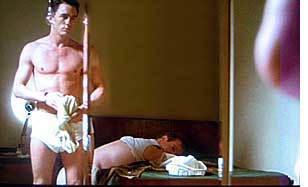 The
film opens with Dyer literally falling through a skylight into
Bacon's studio - a chaotic mess that is accurately re-created onscreen.
The walls are covered with splotches of paint, the floor littered with
X-rays, medical pictures and crime photos. Bacon finds the clumsy burglar,
attired in leather, and tells him to take off his clothes and come to
bed and then he can help himself to whatever he wants. The
film opens with Dyer literally falling through a skylight into
Bacon's studio - a chaotic mess that is accurately re-created onscreen.
The walls are covered with splotches of paint, the floor littered with
X-rays, medical pictures and crime photos. Bacon finds the clumsy burglar,
attired in leather, and tells him to take off his clothes and come to
bed and then he can help himself to whatever he wants.
Dyer becomes the
trick who won't leave. Bacon takes him under his wing, buying him expensive
clothes and acting as his mentor. "Her ladyship might be going steady"
declares one of the denizens at the Colony. Bacon introduces them to his
new acolyte as "the twilight world of unhappy poufs" and "the
concentration of camp."
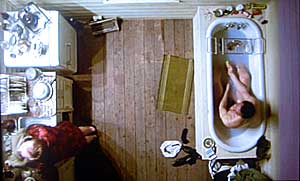 Bacon
was not a very nice man, and the film is unflinching in its portrait of
the artist. He quickly tires of his new boytoy. Dyer is obsessive compulsive,
suffers from nightmares, and drinks heavily. When Bacon finds Dyer passed
out on the floor, he coldly places a compact mirror under the unconscious
man's mouth to see if he is breathing and then walks away. Later, when
Bacon receives the news that Dyer is on the roof of their hotel, threatening
to jump, he snarls "What do you want me to do, give him a push?" Bacon
was not a very nice man, and the film is unflinching in its portrait of
the artist. He quickly tires of his new boytoy. Dyer is obsessive compulsive,
suffers from nightmares, and drinks heavily. When Bacon finds Dyer passed
out on the floor, he coldly places a compact mirror under the unconscious
man's mouth to see if he is breathing and then walks away. Later, when
Bacon receives the news that Dyer is on the roof of their hotel, threatening
to jump, he snarls "What do you want me to do, give him a push?"
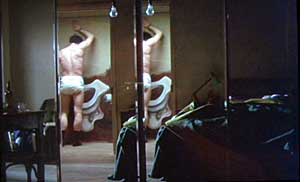 There
are two compelling reasons to see this film. The first is a bravura performance
by our own Sir Derek Jacobi as Bacon. Jacobi, best known for the title
role in the BBC's I, Claudius, comes from the same generation of
British stage actors as Sir Ian McKellen. (Jacobi
also once starred in Breaking The Code - both on stage and then
on film - as Alan Turing, the mathematician who broke the Enigma code
during WWII, helping the English win the war. Years later Turing was jailed
for being homosexual and killed himself.) In Love
is the Devil, Jacobi literally becomes Bacon, inhabiting
the role with the skill of a master thespian. He excels at playing a bitch
but he still finds the painter's humanity beneath the surface. Amazingly,
he is also a dead ringer for the late artist. There
are two compelling reasons to see this film. The first is a bravura performance
by our own Sir Derek Jacobi as Bacon. Jacobi, best known for the title
role in the BBC's I, Claudius, comes from the same generation of
British stage actors as Sir Ian McKellen. (Jacobi
also once starred in Breaking The Code - both on stage and then
on film - as Alan Turing, the mathematician who broke the Enigma code
during WWII, helping the English win the war. Years later Turing was jailed
for being homosexual and killed himself.) In Love
is the Devil, Jacobi literally becomes Bacon, inhabiting
the role with the skill of a master thespian. He excels at playing a bitch
but he still finds the painter's humanity beneath the surface. Amazingly,
he is also a dead ringer for the late artist.
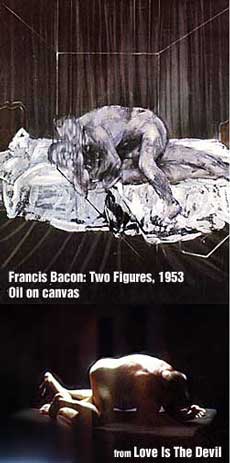 The
second reason is the film's evocative visual style. Director Maybury was
able to turn what normally would be a liability into a great asset. Because
the filmmakers were depicting the painter's actual private life, the estate
of Francis Bacon refused to allow any of his paintings to be used onscreen.
Using great ingenuity, Maybury makes the film itself a Bacon. The
artist's searing images become the film's visuals. Faces are distorted
in smoked mirrors and beer glasses, naked lightbulbs dangle predominately
in the frame, a reflection in a series of three bathroom mirrors recalls
the painter's many triptychs. A nude and contorted acrobat perches on
a diving board, symbolizing Dyer's final fall into the abyss. This, and
the film's opening image - a key going into a lock - reproduce two panels
from a famous triptych painted in memory of Dyer's death. Those unfamiliar
with Bacon's paintings will miss the many visual references, though they
would probably recognize the master's work immediately should they walk
into an art gallery after seeing the film. The
second reason is the film's evocative visual style. Director Maybury was
able to turn what normally would be a liability into a great asset. Because
the filmmakers were depicting the painter's actual private life, the estate
of Francis Bacon refused to allow any of his paintings to be used onscreen.
Using great ingenuity, Maybury makes the film itself a Bacon. The
artist's searing images become the film's visuals. Faces are distorted
in smoked mirrors and beer glasses, naked lightbulbs dangle predominately
in the frame, a reflection in a series of three bathroom mirrors recalls
the painter's many triptychs. A nude and contorted acrobat perches on
a diving board, symbolizing Dyer's final fall into the abyss. This, and
the film's opening image - a key going into a lock - reproduce two panels
from a famous triptych painted in memory of Dyer's death. Those unfamiliar
with Bacon's paintings will miss the many visual references, though they
would probably recognize the master's work immediately should they walk
into an art gallery after seeing the film.
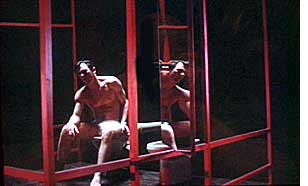 Love
is the Devil is subtitled Study
for a Portrait of Francis Bacon and this is appropriate.
This is not a conventional narrative, but a series of impressions; not
unlike the countless self portraits the artist painted throughout his
life. Love is the Devil is
the antithesis of the usual Hollywood bio-pic where historical figures
are usually de-gayed (like Charlton Heston as Michelangelo in The Agony
and the Ecstasy). This is a film that unfolds in layers and yields
new discoveries on each subsequent viewing. Is it for everyone? Probably
not, but adventurous filmgoers - and lovers of Bacon's art - should find
it spellbinding. Love
is the Devil is subtitled Study
for a Portrait of Francis Bacon and this is appropriate.
This is not a conventional narrative, but a series of impressions; not
unlike the countless self portraits the artist painted throughout his
life. Love is the Devil is
the antithesis of the usual Hollywood bio-pic where historical figures
are usually de-gayed (like Charlton Heston as Michelangelo in The Agony
and the Ecstasy). This is a film that unfolds in layers and yields
new discoveries on each subsequent viewing. Is it for everyone? Probably
not, but adventurous filmgoers - and lovers of Bacon's art - should find
it spellbinding.
[Reviewer's
note, June, 2007: When I reviewed this film back in 2005, I never mentioned
the actor who plays George Dyer. He is none other than the new James Bond
- Daniel Craig. At the time, I was unfamiliar with his work as an actor,
and my space in the paper was probably limited and so I chose not to mention
his name - or Tilda Swinton's
- in order to have more room to talk about Derek Jacobi and about the
film's Bacon-esque visual style. Craig delivers a strong performance as
Dyer and he's quite easy on the eyes as well. And, because he also goes
the full monty a few times, this film is now a featured selection on almost
every gay movie distributor website. I am sure that his presence will
widen the film's audience. There will probably be a new DVD box soon too
that features him on the cover. Oh wait, he always has been on
the DVD cover in his underwear. Never mind.]
More On Derek Jacobi:
Achilles
Tilda Swinton also
appears in:
Caravaggio
Edward
II
|


